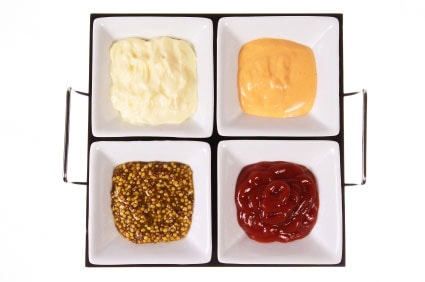
Written By: Sofia Layarda, MPH
Title: Master of Public Health
Alumni: University of California, Berkeley
Last Updated on:

Condiments add the finishing touches to our meals. Some people insist their scrambled eggs are not quite the same without a squirt of ketchup; others swear that just the right amount of mayonnaise gives their special home-style potato salad its unique taste. There’s no question that condiments add flavors to our foods, but did you know most condiments are high in salt, fat, or both? Keep reading to find out how your favorite condiments stack up. When reviewing these numbers, keep in mind that 1 teaspoon of table salt contains 2400 mg of sodium.

Table of Contents
At its most basic, mayonnaise is an emulsion of oil and vinegar or lemon juice held together by egg yolks as a stabilizer. Popular as a base for many dips, spreads, and dressings, regular mayonnaise is a high-fat condiment to be used sparingly when needed. A tablespoon of regular mayonnaise typically contains about 10 to 12 g of fat, depending on brand. The amount of saturated fat and cholesterol varies depending on the type of emulsifier used.
This condiment is exactly what its name describes: cream that has been “soured” by adding bacteria. It is popular for dips and spreads, or as topping on baked potatoes, chili, ad soups. Regular sour cream is 18% butterfat, but many low-fat or non-fat varieties are available on the market, most of which will have additional thickening agents.
Mustard is a paste made from ground mustard seeds, vinegar, and seasonings or herbs. The type of seeds and seasonings used varies, depending on the ethnic influence.
Most commonly made from cooked, pureed tomatoes with spices and seasonings added, ketchup can actually be made with items as varied as peppers or fruits.
This Japanese fermented soy bean paste is popular as a base for broth, and is increasingly used in marinades for grilling, roasting, or broiling. It is very high in salt. Because miso is so intensely flavored, just a small amount is needed in each use.
Another Asian condiment that has gone mainstream, soy sauce is also very high in sodium – about 300 mg in just a teaspoon. A packet of soy sauce that comes with takeout or delivery usually contains two teaspoons, so just pouring one packet over your meal will ramp up the salt content by 600 mg! If you do use soy sauce frequently, consider switching to the low-sodium version of your favorite brand, which contains 25% to 50% less sodium per serving.
Condiments can have their rightful place at your table and in your kitchen, but be smart about how much you use to complement your cooking and nibbles.
Alumni: University of California, Berkeley – Sofia believes in bringing back fun and pleasure into everyday eating. She loves cooking, and is constantly experimenting with ingredients, creating recipes and trying them out on family and friends. Her latest interest lies in finding realistic and practical ways of environmentally-friendly food/eating habits.
condiments, ketchup, mayonnaise, miso, mustard, sour cream, soy sauce
Parsnip: Nutritional Values and How-To
Interesterified Fat: Different From, Yet the Same As Trans Fat?